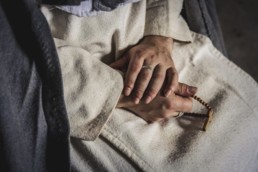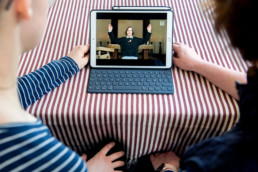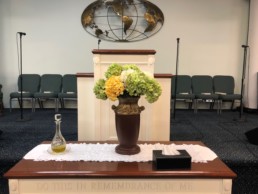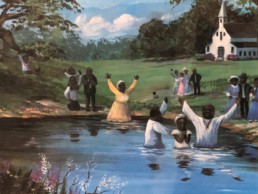A Shelter in the Bronx Where the Homeless and the Friars Shelter Together
A version of this story was published in Religion News Service
A Shelter in the Bronx Where the Homeless and the Friars Shelter Together
Zoé Chevalier | zc2504@columbia.edu
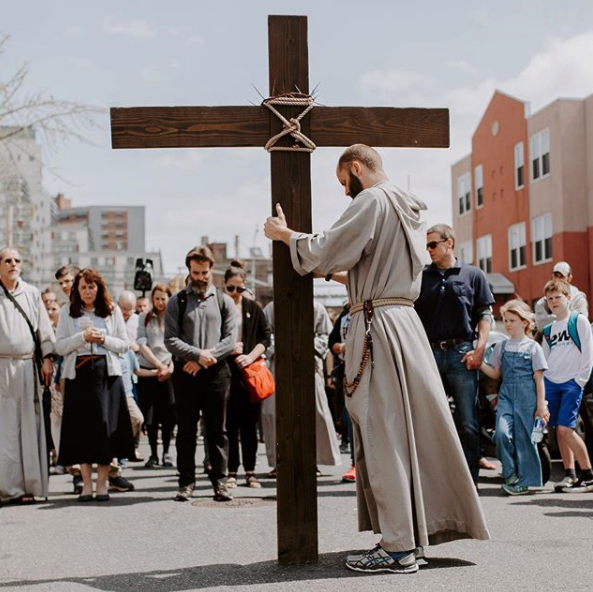
On a sunny spring afternoon, a dozen men stand around a cornhole game. The excitement is palpable. On a video of the event, they are laughing, screaming and high-fiving each other while a loudspeaker projects the voice of the organizer. The video slows down to enjoy the gripping moment when the bean bag-like object enters the goal. Points are scored. The excitement builds. Things seem normal. But upon closer look, this group of friends consists of two very different populations: Franciscan friars, in their traditional grey habit, and homeless men.
The video was shot in mid-April by one of the missionaries at the Saint Anthony Shelter for Renewal on East 156th Street in the South Bronx. The game takes place in the courtyard area of the complex that was once a Catholic school. It has been transformed to host two friaries (St. Crispin and Our Lady of the Angels), a homeless shelter, a youth center and an auditorium. Friars and guests live in a community with each other, but the COVID-induced quarantine has intertwined their lives more than ever.
The men gathered at St. Anthony’s are an unusual response to the COVID-19 pandemic. The friars have chosen to be close to the men they serve, in effect quarantine with them until the danger passes. While they share meals, prayers and recreation, they do their best to maintain social distancing rules.
It has been something of an adjustment, both for the friars and for the homeless men. The friars have to contend with serving three meals a day, and keeping the shelter running around the clock. The guests have had to follow strict rules about drugs, alcohol and even bedtime. In the process, they have become a community.
“It’s been a challenge for them and for us, but there is a feeling that we are all in this together,” says Father John-Mary, one of the friars.
***
The Saint Anthony shelter is part of the Franciscan Friars of the Renewal, a community that was founded in the Bronx in 1987 by Benedict Groeschel and seven others. As Catholics, the friars follow the direction of the Pope, and their main values are those of poverty, chastity and obedience. But the friars distinguish themselves by continuing the tradition of St. Francis of Assisi, known for his life of penance, charity and solitude.
“We live things a little more intentionally or intensely,” says another member of the friary, Father Mark-Mary. The friars devote themselves to a life of poverty, living in the hardest neighborhoods, begging for food and depending on donations for survival. They have no personal bank accounts, little technology and devote themselves to serving the poorest. If a neighborhood got “too nice,” the friars are asked to leave to a more impoverished community, according to Mark-Mary.
The friars believe in a hands-on approach to helping the poor. “The Gospel tells us to take care of our neighbor,” says John-Mary, adding that he believes in the approach of “Give them a sandwich, not just a blessing.”
This Franciscan order has 15 friaries and about 140 friars around the world, including Ireland, Nicaragua and Honduras. At the St. Crispin Friary in the Bronx, where the shelter is located, there are about 10 friars, 20 missionaries, volunteers who come to live in the community for a year, and 30 guests, in need of shelter. It is hard to get an exact number because the friars seem to live in a number-free community, there are no limits on how many friars can join, there will always be room for one more.
***
Father Mark-Mary, has been with the community for 11 years, and although he lives in the other friary, Our Lady of the Angels, he now has to help out at the shelter. Mark-Mary is usually in charge of a youth program, teaching catechism to children of the neighborhood, but since the pandemic started, the complex closed its door to the outside, and the classes transitioned to Zoom. Now, he works one day a week at the shelter.
His interest in the Franciscan order came in a rather unexpected way. One night as a teenager in Orange County, California, where he grew up, Mark-Mary says he was eating at In'n'out Burger, a classic fast-food chain in California when a young man approached him and started talking about this unusual order. He was talking about “hard-core Franciscans who sleep on the ground,” said Mark-Mary, and his interest was piqued. Fresh out of college, Father Mark-Mary came to join the friary.
Joining the order is a serious process. First, the applicant does a few phone interviews with the friars, in order to assess his interest. The next step is to come visit. Once a month pre-quarantine, the friars would welcome the potential new recruits for an introduction into the friar's life. In May, applicants are invited to stay for a couple of weeks, in which they are required to take a psychological exam, to make sure that they can take on a life of penitence and service.
Postulants then start in September for 10 months, after which they are allowed to leave or go on to Novitiate, during which they start wearing the habit and choose a religious name. Four years later are the final vows. The final step, if the new Friar wants to become a priest, is to study for another four years of seminary, after which they can be ordained.
***
This strict life is often very different from the one their guests live. The Friars pray together four to five hours a day, according to Father Mark-Mary, and most of their remaining time is spent serving others at the shelter, the food bank or the youth program that they run. There is often not much time for leisure, and the commitment is complete and life-long.
Before the quarantine, Jorge, one of the guests at the shelter, would spend his days walking around the neighborhood, take the subway downtown and go to WholeFoods, get a coffee, sit in the park and watch a movie, he would wait for the time to pass until he could get back to the shelter. Some other guests spent their days at the library, where they could watch movies on their phones or play chess together. Others would go to work or look for a job or apartment. Some had social workers meetings and programs to go to.
Every night, Jorge would take the mandatory breathalyzer, and drop his belongings in box 23. These were things like food and pills that were not allowed in the rooms, he also had to give away his phone, which stayed in the office for the night. The men’s belongings are often searched for drugs, alcohol, cigarettes, and any “risqué publications,” all forbidden according to John-Mary. Brother Patrick explained that “It is a catholic environment, guests are immersed in the norms of the community,” although they do not have to be catholic to be offered a room.
Jorge would then have dinner and activities with the men, and retreat to his room. At 9 p.m. the lights would go off and come back on at 5:30 a.m. the next day. Jorge is not a morning person, and having to do all his chores, shower, eat breakfast and be out the door by 6:45 was always a struggle. He would often forget his wallet behind.
These different lifestyles often clash. “I don’t like my freedom taken away from me,” says Jorge, laughingly, adding that he is very grateful the friars offered him a place to stay, and that “They are very strict but there is a reason why (...) I've never heard of a shelter like that.”
***
The shelter runs on order, discipline and a fine-tuned schedule. But now everything has changed. Having the men stay in around the clock while maintaining social distancing rules has been a challenge. The guests now eat in shifts, to avoid being all in the same room at the same time, they wear masks, and most importantly, are not allowed out of the complex.
Some rules have changed during the quarantine, so the men are allowed to have their phones during the day, and smoke in the little garden outside the shelter. Jorge used this opportunity to connect to his sister's Netflix to watch action movies and play games on his phone to avoid getting bored.
To occupy the guests, socially distanced movie nights are organized every other day, where they watch “family-friendly movies” found on Pureflix, a Christian version of Netflix.
The friars even buy guests cigarettes, but only three or four are allowed a day. Jorge, who just left the shelter to live with his mother, laughs during our interview: “I’ve already smoked three since we started talking!”
The shelter structures and discipline is good for him, Jorge thinks, but he also struggles with the added control exerted on him during the quarantine. Now he only gets out once a week for his medical visit, driven by one of the friars. Before leaving the complex, he had to explain why his appointment was necessary and let one of the friars speak with his doctor. “I didn’t sign up for that,” says Jorge. He was uncomfortable with his doctors learning that he was homeless.
***
Because of high demand, Jorge’s spot at the shelter was not easy to get, and he was willing to sacrifice some liberty in order to be part of this special community. When the quarantine started, he had already been there for five months but decided to stay at the shelter.
Jorge used to be a cook, but his life took a turn when he lost his job due to a disability that made it hard for him to walk and breathe. He would drop hot pans in the kitchen, shaking, he would put himself in danger, and was eventually fired. Without this income, he soon wasn't able to pay for rent, and his landlord decided to take him to court. Jorge packed his belongings in a big bag and left his Bronx apartment, where he had been living for the past 12 years with nowhere to go. He headed to 14th street and spent a week sleeping in a park, in the subway, or on a makeshift bed in front of the Salvation Army.
He relied on people he met on the streets to figure out his next move: “I had never been in this environment, I had never been homeless before,” he says. One day he met a man who told him about a shelter on Lafayette Street, he headed there and stayed a few nights. There he met another man, who had just come from the St Anthony shelter, and got kicked out because he started using again. There might be a free bed now he said, Jorge trekked to the Bronx to try.
At 6:30 p.m. every evening, men lined up at the door of the Saint Anthony Shelter for Renewal in the Bronx, coming back to one of the 30 beds available for the night. Some had been there since 9 a.m. to get one of the few openings when someone leaves, usually after a six months stay. When the doors opened, they were breathalyzed and had access to a bed, a hot dinner and breakfast. At 6:45 a.m. the next day they would be on their way in the streets of New York City, living their lives for 12 hours before curfew.
Jorge came five days in a row around 5 a.m., he wanted to be first in line in case a bed opened up. On the fifth day, there was an opening and after a negative breathalyzer, he was admitted. In the meantime, he heard that his friend who told him about St Anthony died of an overdose. “He was a good guy,” says Jorge, who himself had been clean for three months “I know what addiction does, ” he added, “I get high in my head and I end up alone, miserable, broke and unhappy.” The shelter provides solace from these problems and a place to reconnect with his Catholic upbringing.
***
Easter was not the most festive this year. Usually, all the friars from across the friaries get together and have a nice meal for Holy Thursday, this did not happen this year. Although the liturgy was the same, “it was all much simpler” said Father Mark-Mary. No flowers decorated the Church, and the doors were not open for Sunday mass. The music was much simpler too, without the usual 15 musicians who would usually come.
But despite their best efforts to avoid any outside interaction, COVID did not spare the friary. Michael Kearney, 23, a missionary has had to quarantine in his room for two weeks as he showed mild symptoms. In an interview, Kearney said that the biography of Mother Theresa, and the tomato soup and grilled cheese prepared by Jimmy, the cook, got him through. He also read the NY Times and watched a lot of Terrence Malick movies.
Five friars have had the virus, including Father Luis, the head of the shelter who Jorge describes as “the rock.” Two missionaries also showed symptoms. The six-floor of the friary has then been converted in a makeshift quarantine zone, where the men isolate and are brought meals three times a day.
Another source of worry was food supplies. The friary usually depends on a New Jersey Food Bank, but deliveries have stopped with the fear that their elderly drivers would be at risk. So others stepped in to deliver food.
Somehow Jimmy, the cook for the shelter always manages. “He’s the best,” says Jorge, adding that during the Holidays, thanks to a donation, all the men were treated to lobster tails and filet mignon. He still remembers it with emotion.
But the most heartbreaking to Father John was to see one of the volunteers who usually help out at the shelter come back to use the Food Bank for himself. After losing his job, he now needed the friars to support him, too.
***
Despite all this, the friars are keeping a hopeful attitude. Father Mark-Mary cited the long tradition of Franciscans serving and dying during plagues and says that it is expected to continue helping others. “We have given our life to suffer with those who are sick and vulnerable,” he says.
Jorge left the shelter a week ago and now lives with his mother in the Bronx. He missed being able to attend mass at the friary for Easter but enjoys the new found freedom he gets from walking around the neighborhood every day. He found a subsidized apartment and looks forward to moving in when the quarantine ends.
“I have been blessed,” says Jorge, who strengthened his Catholic faith at the shelter. “I speak to God in a normal basis, like he was a normal person.”
Preaching in the times of Corona
Preaching in the Times of Corona
Zoé Chevalier | zc2504@columbia.edu
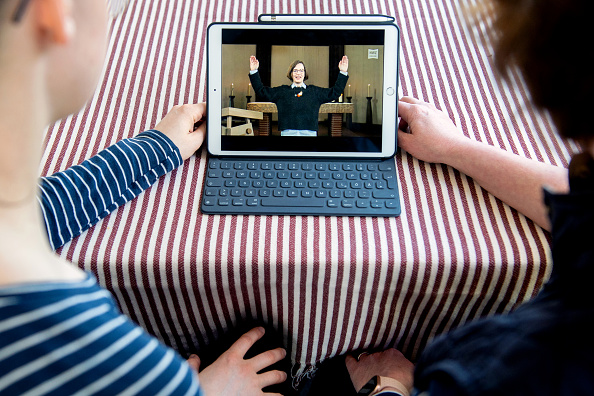
This Sunday is not like any other. There is no singing and dancing, no coming together and hugging at the United Pentecostal Church in Harlem. Instead, Pastor Michael Grattan is alone in his office, preaching on Facebook Live, while comments pour in: “I’m watching from Wisconsin,” says one, many just send “Amen,” another one just says “I made it!”
It was not easy to connect to the Pastor’s sermon this morning. There were technical glitches, and the video stopped in the middle, leaving only a 7-minute segment available. These are the realities of preaching in the times of Corona.
The Church on 125th closed its doors on March 22nd for Sunday services but remains open for weekly prayer and Bible study on Wednesdays and Fridays. There, the few congregants sit on different benches and avoid getting close to each other.
If Bible study became online, the pastor fears that he would lose the back-and-forth conversations that are at the heart of the experience. He also fears that he will have to simplify his lessons because he thinks it is harder to explain complicated concepts online: “I see these TV evangelists,” he says, “they have 10,000 people in one room, but everything they say is so basic.” Especially now in this time of crisis, Grattan says he wants to focus his next lessons on the book of Revelations. “There is a hunger for it,” he says.
The Book of Revelation is the last book of the Christian Bible, written by an unidentified “John”. According to Pastor Grattan, the book recounts how the Antichrist will come down to earth and tempt humans to follow him, those who do will be stained by the “mark of the beast” and have their soul destroyed. This apocalyptic tale fascinates believers according to Grattan, as all try to find resemblances between the text and modern-day life. The virus is only intensifying a question that Christians have been asking themselves for hundreds of years: “Are we in the end times?”
Grattan’s Sunday sermon focused on a more positive message, one of hope: “Once we overcome the fear of death, we are able to overcome all anxieties in life,” he says on the screen, adding: “If we do what we can, God will do what we cannot.”
The cancellation of Sunday service came as a relief to some according to Iris Grattan, the daughter of the pastor. She says that worshippers were worried about sinning by not going to Church to protect themselves from the virus. “[They thought] am I being fearful and not believing in God? Iris says.
Grattan worries about his ability to connect with less technically-savvy members of the community, like those who do not have access to Facebook. Some older members have only an old flip phone, others do not even have a cellphone. Grattan tries to stay connected with them through texting and calling, but he does not know how he will keep the connection strong in the future. “I don’t have answers yet,” he says, “I have never been faced with this before.”
The Holy Spirit
The Holy Spirit
Zoé Chevalier | zc2504@columbia.edu
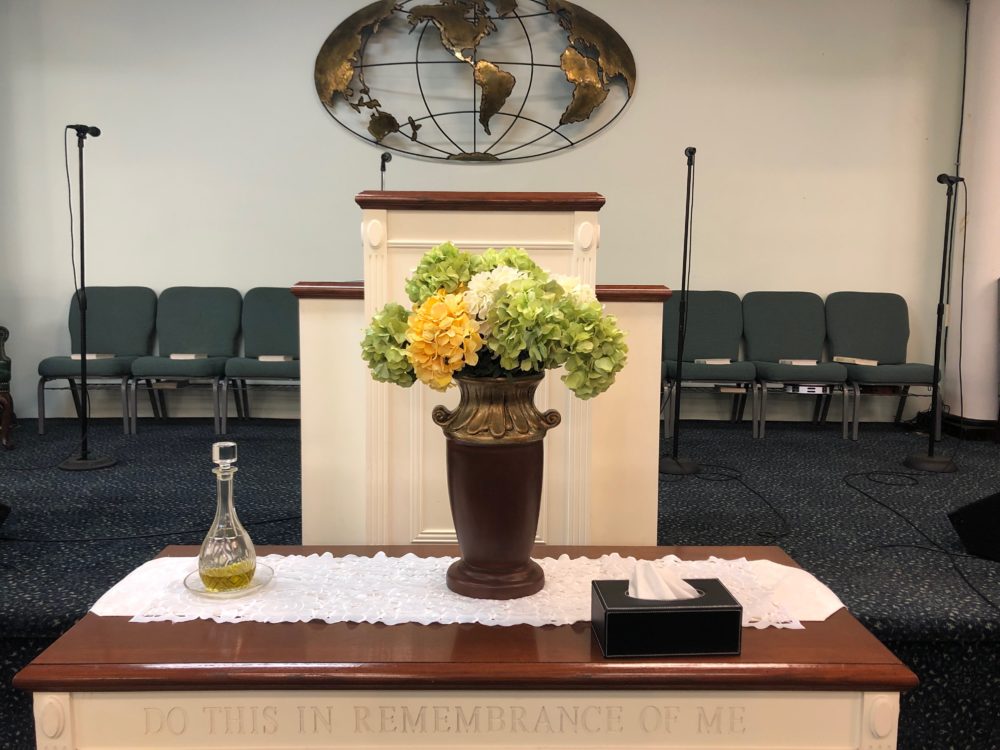
The congregation slowly gathers inside the prayer hall at the United Pentecostal Church on 125th Street, between Broadway and Amsterdam. Sunday school ran a little late, but that’s ok, there are no formal hours here. The prayer service will last for about two and a half hours, but none of it will be passive: Worshippers will stand, move, dance, and sing.
Rows of chairs face a stage, where microphones and instruments—an electric piano, drums and a tambourine—signal the singing to come. No crosses, stain-glass windows or icons of saints can be seen here. Although Pentecostals believe in Christ, the traditional crucifix found in Catholic churches is replaced with a large statue representing the earth and a collection of flags from different countries. In front of the pastors console is a wide communion table, covered by a white veil. “It’s to make it look religious,” says Pastor Michael Grattan.
Patrice Martin has come all the way by bus from Philadelphia to be here today. Grattan witnessed to her 40 years ago, when she was a college student. “He saved me,” says Martin. But she feels directionless, and came to the Church to reconnect with the one who once helped her. Martin does not want to bother him, and so she sits in a corner. When the pastor comes to say hi, she introduces herself as Sister Patrice Martin. He thinks about it and says, “That’s strange. I witnessed to a Sister Patrice many years ago.” They fall into each other’s arms.
One of the singers, dressed in all white comes up to the audience, arms opened. “Let’s have a group hug,” she says. Slowly, she walks away into a corner of the room, where worshippers gather. A circle is formed. At first quiet, the circle soon comes to life. The Holy Spirit is about to arrive. Worshippers are moving their hips and raising their hands, opening their mouths wide. The rumble of their feet on the ground creates vibrations, which are growing throughout the church.
A symphony of different languages is spoken all at once: English, French, Spanish and many other languages that I do not recognize. Most of it is unintelligible, with a repetition of “Amen” and “Hallelujah,” creating a rhythm, and growing faster, louder, more passionate.
Another singer is brought into the middle of the circle. Surrounded by her peers, she bangs her chest right above her heart and moves her hands to the rhythm of her words. They are praying for her. Some are smiling, looking up at the heavens, at times letting out a powerful laugh.
Others give out painful moans, bow their heads.
Brother Philippe comes up to me and explains in French. “They are letting the Holy Spirit speak through them. They just open their mouths and let him speak.” Like many people here, Philippe was once a Catholic, but he grew tired of needing intermediaries to speak with God. Pentecostals do not believe in the Virgin Mary as the first interlocutor. “It’s like parents with their children,” explains Philippe. “You do not need to have your mother always intervene on behalf of you to your father, you have to go directly.”
Pentecostals believe in a direct approach to the Lord. No Saints, no Virgin Mary is needed as intermediary. Once a person has been “saved,” the previous “sinner” becomes a saint. All baptized members of the church are saints. They can speak directly to God, and let the Holy Spirit speak through them. They are also called to “witness” to other “sinners,” and transmit the word of the Lord.
This ritual is rooted in the day of the Pentecost, a passage in the Bible’s Book of Acts, the fifth book in the New Testament. According to Acts 2:4, the Holy Spirit descended upon Jesus’ apostles, baptizing them in the Holy Spirit, “and there appeared unto them cloven tongues like as of fire, and it sat upon each of them. And they were all filled with the Holy Ghost, and began to speak with other tongues, as the Spirit gave them utterance.” Pentecostals believe in a literal interpretation of the Bible, and see speaking in tongues as an act that can happen at any time, to anyone who has been saved.
This speaking in tongues continues throughout the service. Sometimes, as Grattan is preaching, someone will start laughing uncontrollably, someone else will speak in a different language. Once some people started making snake-like noises in the back of the room, the hissing sounds growing louder. When the Holy Spirit wants to speak, you let him in. As the service progressed, Grattan’s sermon grows more passionate:
“Don’t waste your alone time and your suffering, praise the Lord and nothing should offend you. If you can’t run, walk, and if you can’t walk, roll, but keep following God. We are the chosen people, the Second Testament says so! We are like the Jews.”
Suddenly, he stops, and the voices in the crowd go silent. One by one, some worshippers go up in front of the stage and kneel in front of the pastor, waiting to be blessed. A pregnant woman bows with difficulty. Children run up to the stage.
The adults wait patiently as Grattan slowly kneels to their level, holds their head and whispers “In the name of Jesus Christ.” Slowly they go back to their seats, calmer, blessed. Sister Patrice stayed in her seat the whole time, her eyes closed, praying. At times, she called out “Amen, Halleluyah.” A glorious smile was spread across her face.
Job and the Super Bowl
Job and the Super Bowl
Zoé Chevalier | zc2504@columbia.edu

Fewer congregants come to Bible study on Wednesdays than on Sundays at the United Pentecostal Church in Harlem. But it is no less spirited. On a recent Wednesday, seven worshippers sit in the prayer room in front of Pastor Michael Granttan. Despite his whitening hair, Grattan is an energetic man, often jumping to his feet to illustrate a lesson. He is dressed in casual clothes: A knitted sweater and pants have replaced the suit of Sunday’s service.
Grattan’s teaching style is a combination of Bible verse study, personal anecdotes, sports references and modern-day cultural applications. During the first part of the lesson, people in the audience are encouraged to ask all the questions they want, both Biblical and personal.
A young woman, whom I recognize as one of the singers of Sunday’s service, starts off by asking, “How do we know if the hardship we have been given comes from God?”
She proceeds to tell the tale of a family member who had been diagnosed with breast cancer and refused treatment, waiting for God to cure her. One day, she went to a naturopathic doctor who gave her an ointment to put on her breast. This, she said, led to an emergency mastectomy. The woman found out that during the year and a half that she had not been given treatment, the tumor had not metastasized. She praised God for protecting her. Her husband, however, blamed her for losing faith and getting the surgery, saying that God was not done curing her.
Hearing this story, Grattan stands, raises his arms and starts preaching the story of Job from the Book of Job, which is part of the Old Testament.
“Job’s animals were kidnapped!
The house fell over his children!
And then he got sick! And we know there is nothing more personal than disease. There was puss coming out of his body, it was truly horrible, but he never stopped praising the Lord.”
Grattan then uses one of his favorite sports allegories to illustrate his message: “Job was hit so hard, like in a boxing ring, poom the boxer, he got a hit with a right fist then a left fist, then he got a full-body blow!” Mimicking the scene he throws his fists in the air, punching an invisible Job.
Soon, he sits back down, saying, “We know that God gave him those hardships, but generally speaking, there are no parameters that define whether or not a hardship comes from God, we create a lot of our own problems, but we need to continue to praise God no matter what.”
He adds that he believes in going to the doctor, because “God can cure you anywhere, on the operating table as well as in your kitchen, so let him cure you though your doctor.” With a deep sigh, he concludes: “I understand, as you know sister Grattan died recently.” The crowd goes silent. Everyone knows about the recent death of the pastor’s wife to cancer.
During the second half of the session, Grattan doesn’t shy away from getting into contemporary pop-culture discussions. He comments on the Superbowl half-time show, featuring Shakira and Jenifer Lopez, saying, “I don’t understand all the fuss about the fact that it was not family-friendly.” When someone brings up that Jennifer Lopez might have been mocking the sign of cross, he defends her. “No! She was simply pole dancing!”
Grattan often tries to tone down more conservative branches of the church. “I believe in balance. God is not stupid, only human beings are. Be careful about turning principles into law.” When someone in the church asks if women are allowed to wear pants, he says of course. “And what about swimsuits?” asks a man. “Is it true we are not allowed to go to the beach or swimming pool even on a hot day?” Another woman laughs. “I go to the beach!” she says. Grattan ends the discussion saying, “Yes you can. I also believe that there are apostolic swimsuits that are more modest.”
At the end of the study session, Grattan gets more serious, and passes around a sheet of paper: “A brief look at the errors of the doctrine of the Trinity.” The document is filled with typos as the pastor has “whipped it out” quickly this afternoon. Once again, Grattan stands up, agitated.
“99 out of a 100 times, 999 out of 1000 times..”
His voice grows louder.
“9999 out of 10000, and I could keep going… people turn to Genesis 1:26 to justify that God is plural.”
Genesis 1:26 is part of the Old Testament and says: Then God said, “Let us make mankind in our image, in our likeness, so that they may rule over the fish in the sea and the birds in the sky, over the livestock and all the wild animals,[a] and over all the creatures that move along the ground.”
Everyone pulls out their phones to look up the verse, and the pastor continues. “Scholars understand that this is not what this verse means, the clergy understands, but no one is teaching laypeople!” According to the Pentecostal Church, God, Jesus and the Holy Spirit are all part of the same entity, not separate beings. He sits back down: “Do you understand?”
A woman in the back raises her hand shyly. “I think that it will make sense once I really go through the scripture,” she says.
“Yes, you need to keep asking questions and work hard, I can’t give you understanding,” Grattan concludes. As the clock strikes 9 p.m., all rise and pray together.

